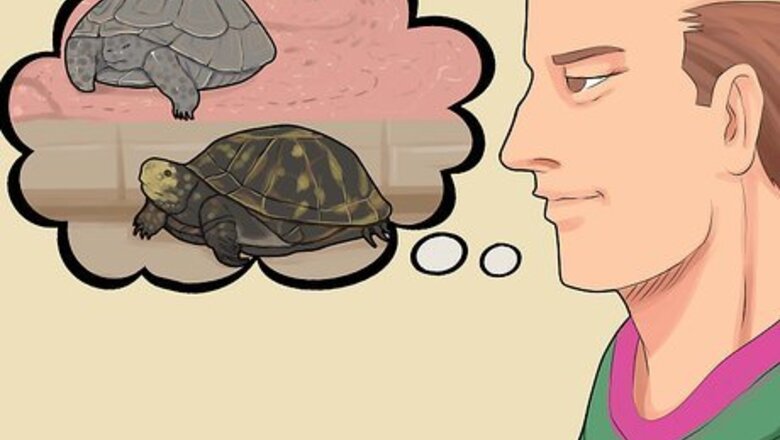
views
X
Research source
Captive tortoises and turtles don't need to hibernate to survive, but annual hibernation periods can increase your odds of breeding success. Research the needs of your specific pet, and follow these guidelines to safely prepare and care for your hibernating turtle or tortoise. Do not force a sick animal to hibernate, and be wary of drowning, freezing, and starving your pet by accident.
Deciding to Hibernate

Determine if your species hibernates. Generally, turtle and tortoise species from tropical climates close to the equator do not hibernate; the farther away from the equator, the more likely that your pet hibernates. Research your specific animal's' requirements before you begin. Species that commonly hibernate are listed below: Box turtles Russian or Horsfield's tortoises Spur-thighed tortoises Marginated tortoises Hermann's tortoises Desert tortoises Gopher tortoises Texas tortoises Wood turtle Spotted turtles Red-eared sliders Snapping turtles

Get a vet to check your pet’s health. Only healthy animals should hibernate. During hibernation, the immune system slows down considerably, and a turtle that was even mildly ill going into hibernation is likely to die during or shortly after the process. Examine your turtle carefully for signs of illness. Even if you see nothing, still have the turtle examined by a veterinarian. Signs of illness include: Swollen eyes. Discharge from the nostrils Swollen ears Low body weight Difficulty breathing, exhibited by opening the mouth frequently Aquatic turtles remaining out the water at night Abscesses or other signs of parasite infestation Wounds or shell rot Strong smell,inflammation, or leaking liquid from underneath the tail Inside the mouth, any of these: the appearance of small blood-spots; deep red-purple tinge; a yellow cheesy substance

Learn how your pet should hibernate. Most experts recommend that you keep your indoor turtles and tortoises indoors and active during the winter, and that you bring outdoor turtles and tortoises inside for the winter if their natural habitat will not be safe.Aquatic turtles can hibernate outdoors as long as it is safe and the water doesn’t freeze. Terrestrial and semi-aquatic turtles and tortoises can hibernate indoors and outdoors. If the animal lives outdoors, it will respond to changes in the temperature and length of sunlight, and instinctively know when and how to get ready to hibernate. If your animal lives indoors, you will need to simulate these changes. Check your local pet club information listings or ask your vet if you are unsure how to care for your pet. Most box turtles and tortoises hibernate between October or November until the late February through early April in the United States. Most turtles and tortoises hibernate for 2-4 months. Some species in some regions can hibernate up to 6 months, though that length of time is not required. Ask your veterinarian for specific recommendations for your turtle.
Getting Ready to Hibernate

Weigh your pet. You should track your pet’s weight throughout hibernation to know if your pet is healthily losing weight or dangerously starving. Weigh your turtle or tortoise now to get a baseline weight, and keep weighing your pet every 2-3 weeks. Use the same scale you will use leading up to and during hibernation. Use a digital scale for animals under 6 lbs (2.5kg) to ensure accuracy.

Feed your pet vitamin A during the summer. Before you fast your turtle or tortoise, you should feed your pet higher levels of vitamin A since hibernation depletes stores of vitamin A. At the beginning of summer (12-16 weeks before hibernation), begin adding vitamin A-rich foods to the turtle's diet. You can simply swap out some of these foods for other things your turtle normally eats. Some good sources of vitamin A include: For tortoises: carrots and squash For turtles (non-meat): Leafy green vegetables like kale, broccoli, mustard and collard greens, and dandelions; orange vegetables, like alfalfa, squash, carrots, sweet potatoes; orange fruit, like cantaloupe and peaches For turtles (meat): fish and baby mice If your pet already gets a lot of vitamin A, just keep feeding it as normal.
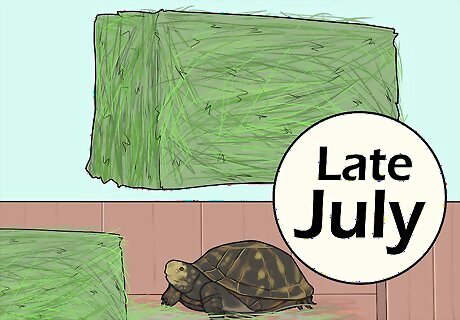
Increase your pet’s fiber intake. Towards the end of summer (late July, or 6-8 weeks before hibernation), swap out some of your turtle's normal food for higher-fiber options. Good sources of fiber for both turtles and tortoises include alfalfa and timothy hay, both which are high-fiber weeds and grasses. If your pet normally eats a high-fiber diet, just keep feeding him as usual.

Fast your pet 2-6 weeks before hibernation. Many turtles and tortoises die because owners hibernate them with undigested food still in their digestive tract. Do not try to hibernate a turtle or tortoise who has eaten within the last month; instead, delay hibernation. Ask your vet for a specific fasting time for your species. Undigested food kills hibernating pets in 2 ways. Either the food decays and causes fatal bacterial infections inside your pet; or the food decays and creates large clouds of gas, which press internally on your pet’s lungs to suffocate it. When in doubt, contact your vet. Your pet’s digestive system is controlled to a large extent by temperature. Tortoises can need 3-6 weeks. Small tortoises (<1kg) need 3 weeks; medium sized (1-1.5 kg) need 3-4 weeks; large tortoises (2-3kg) need 4-6 weeks. Turtles need roughly 2-3 weeks. A small turtle like a Box turtle might need only 10-14 days.
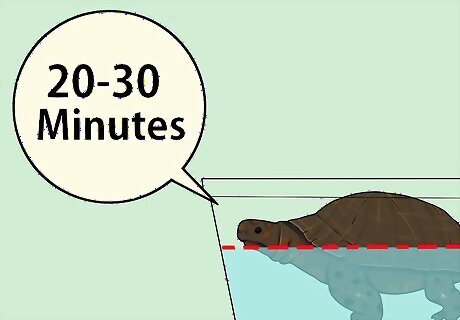
Hydrate your pet. While fasting, soak your tortoise or turtle every other day 20-30 minutes in chin-deep water. Ensure your turtle or tortoise has access to drinking water constantly, from now until the end of the entire hibernation. This helps encourage the tortoise to expel waste from its digestive tract and stay hydrated.

Decrease the temperature before hibernation. Temperature determines your pet’s metabolism, which is why hibernation happens when it is cold. Ensure that all food is out of your pet’s body before you go onto the next step. Do not go below 50°F (10°C). Turtles: start 1 week before hibernation. 65°F (18°C) for 2-3 days, gradually reduced to 60°F (15°C) over 2-3 days, then gradually reduced to 50°F (10°C) or a little below. Tortoises: start 4 weeks before hibernation. Gradually reduce temperature to 60°F (15°C) over 1 week, then keep temperature 55-60°F (13-15°C) for 3 weeks so your tortoise can fully digest its last meal. 50°F (10°C) is the maximum (warmest) temperature for hibernation to occur. If your turtle or tortoise is at 50°F (10°C), they will begin to hibernate.
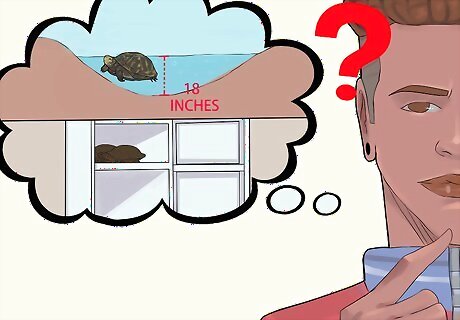
Decide where your pet will hibernate. Most pet owners use fridges for indoor hibernation, but only with a lot of care and caution. Make sure your turtle or tortoise is completely safe from predators such as rats, which like chewing on hibernating tortoises. If you have an aquatic turtle that is staying in water outdoors, make sure the water does not freeze and has a depth of at least 18 inches. If your pet is staying indoors, scope out a cool location in your house for your turtle or tortoise. Many people use refrigerators. Others use garages, basements, or any room at room temperature. Pick a location that stays above 50°F (10°C) as its default. If your power goes out, your pet escapes, or another accident occurs, you want your turtle or tortoise to live despite the temperature change.

Prepare your fridge, if needed. If you are choosing to place your pet in a fridge for hibernation, you must watch your fridge and pet carefully to avoid death. Ventilate properly. A fridge is air-sealed, so you must provide air to your turtle or tortoise. Open the fridge door at least 3 times a week, for 1-2 minutes. Test the fridge temperature. Place a thermometer in the fridge and monitor its fluctuations and accuracy. If there is a lot of temperature fluctuation, fill your fridge with other masses, like water bottles, that will hold the temperature steadier than just air will. Pick a fridge that you will not be using often throughout the day. Opening and closing the door often can deregulate the temperature, as well as flicker the fridge lights on and off.

Check your pet regularly. Your tortoise or turtle might become less active, but it should still seem alert and reactive. If your pet is sick, listless, or otherwise abnormal, check with your vet. Do not go onto the next step: hibernation can kill a sick turtle or tortoise.
Making a Hibernaculum

Pick your boxes. A hibernaculum is a small container for your turtle or tortoise to hibernate, and it protects your animal from hazards. Take two boxes: one about twice or thrice the size of your animal, and one only a few inches larger than your animal. The smaller box should fit into your large box with an inch or two on each side. Your outer box should be made of sturdy material able to withstand chewing by rats. Use plywood, plastic, or wood. Do not use cardboard. Your turtle or tortoise should be able to turn around in the smaller box, but not wander a lot.
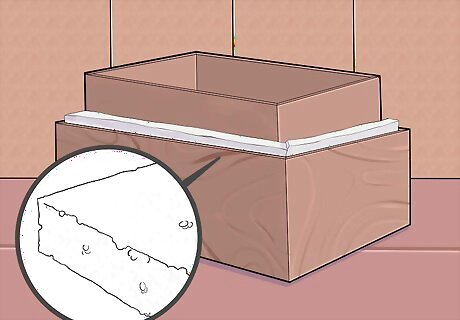
Pick your insulation. This is a critical step. You need material to fill the gaps between the large and small box, when the small box is placed inside the larger one. This will help regulate your pet’s temperature, and keep your pet from dying or leaving hibernation too early. The best insulation is polystyrene or packing foam. Alternatives include insulation from housing or packing projects. If you need, tightly packed shredded paper can work too.

Add a thermometer. A thermometer is absolutely necessary for checking the temperature in your pet’s environment. You will be checking your thermometer often, so get one you understand and can use well. Many pet owners like using a classic maximum-minimum reading thermometer from any garden or hardware store. Some pet owners like using thermometers with alarms that sound when the temperature gets above or below a certain reading.
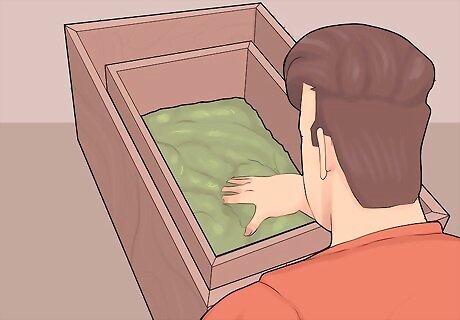
Assemble your box. Place a bottom layer of insulation in the large box. Place your small box in the middle of the large box, on top of the layer of insulation. Add the rest of the insulation around the sides of the smaller box. Put insulation on the top lid of your boxes. Drill small ventilation holes in the lid. Cover the bottom of your smallest box with some substrate. Some examples of substrate include: coir (crushed coconut husk) straw shredded newspaper peat moss commercial substrates for reptiles, such as Carefresh or Bed-A-Beast Do not use substrate with fertilizers, plant food, or any chemical additives Check the appropriate moistness of your substrate for your species of pet. For example, box turtles need very moist substrate that is almost wet. Turtles and tortoises use up very little oxygen when hibernating, but still require a small amount of oxygen. Make ventilation holes that are small (less than an inch or centimeter in diameter).
Hibernating

Start hibernation. Make sure that your turtle or tortoise has no illnesses or injuries, no food in their digestive system, constant access to water, and is at a temperature hovering around or above 50°F (10°C). If any one of these things is not true, do not force your pet into hibernation. Otherwise, place your pet in the hibernaculum. Place your hibernaculum in a cool location where it will stay throughout hibernation, except for when you are inspecting it. If your pet is hibernating outdoors in nature and not in a hibernaculum, make sure your pet will neither drown or freeze in its hibernation spot. Your pet should still have constant access to drinking water. If your pet is hibernating outdoors, it will naturally bury itself in or around a pond. The pond should have a good bed of dirt or muck to dig into, and be at least 18 inches (45.7 cm) deep to provide some temperature insulation. If needed, keep the pond from freezing by using a floating pond heater through the winter. If your outdoor turtle will not hibernate, even though the weather has cooled, or you see it swimming or basking a lot after other turtles have disappeared, bring it inside. Some turtles just don't know how to hibernate and will not survive the winter outside.

Physically inspect your pet 1-2 weeks. You cannot hurt a hibernating tortoise or turtle by handling it, but can kill your pet by neglecting it. Do this regardless of where or how it is hibernating, indoors or outdoors. Inspect your pet for any signs of infection, illness, or poor hibernation; and inspect your hibernaculum for urine, feces, or signs of predation (rats). If your 1) tortoise or turtle has urinated or defecated while hibernating, 2) your pet's skin is dry, or 3) hibernaculum is just much wetter than usual, soak your pet for 2 hours in room-temperature water. The water level should happen just below your pet’s bridge. Dry your pet thoroughly, and return your pet to the hibernaculum placed in a slightly cooler location: you had been keeping your pet in a location that was too warm and dehydrated your pet. Signs of infection include discharge, breathing difficulties, and changes in the skin or shell. If you notice anything concerning, call your vet. If your pet’s skin is dry or the hibernaculum is wetter than usual, soak your pet in room-temperature water for two hours.

Stay at 40°F (4.5°C). An ideal temperature for hibernation is around 40°F (4.5°C), though your pet can hibernate 35-45°F (1.5-7°C). Any lower and your pet might suffer permanent damage or death; any higher and your pet will burn too much fat to stay in hibernation, and will start waking up. Check your thermometer at least once a day, if not a few times a day. Check hourly during very cold or hot times. If the temperature is consistently warm or cold for a few hours, change the location of your hibernaculum to a place with a more optimal temperature.
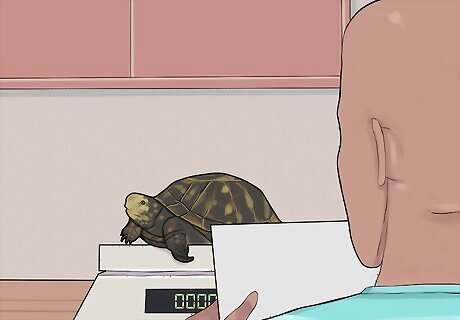
Weigh your pet. Every few days, weigh your turtle or tortoise on the same scale you used before hibernation. Keep track of your pet’s weight throughout hibernation. A healthy turtle and tortoise will lose 0-1% of its body weight for each month of hibernation. Some examples of normal weight loss: A 1 kg tortoise losing 10 g per month A 1.5 kg tortoise losing 15 g per month A 2 kg tortoise losing 20 g per month If your turtle or tortoise is losing weight faster than this, rehydrate your pet by sticking them in shallow room temperature water for 2 hours. The water level should fall just below the bridge on your pet. If your pet loses weight faster than this for more than a week, contact your vet. For instance, a turtle or tortoise that weighs 600 grams (21.2 oz) should lose 6 grams a month. Keep these records for the next time you want your pet to hibernate.
Waking up after Hibernation

Remove your pet from the cold. Before you do anything, double-check the duration of time your turtle or tortoise is supposed to hibernate for; most species fall within 2-4 months. Remove the hibernaculum, if using, and warm your pet to 60°F (15°C). Soak your tortoise or turtle, as you have been, every other day.

Increase the temperature. Keep your pet at 60°F (15°C) for 2 days. Increase to and maintain at 65-68°F (18-20° C) for 2-3 days. Finally, return your pet to non-hibernation temperatures (70°F-80°F, or 21°C-27°C). Waking up is a mirror image of going into hibernation. “Waking up” is characterized by more movement and activity. Drinking water is important throughout this process. However, your pet might avoid food. Keep the temperature warm. Temperature for critical in your pet’s metabolism, and cold temperatures can make your pet vulnerable to illness. Use a heat lamp or focal light to warm up your turtle or tortoise if it is not active or eating properly.
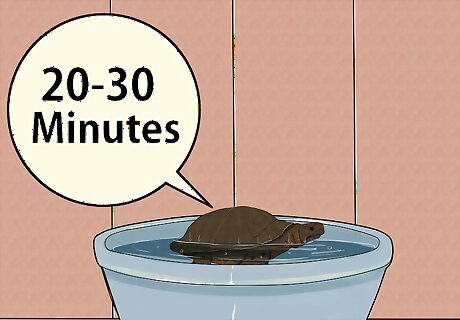
Hydrate your pet. Soak your pet in water 20-30 minutes every other day, as you have been doing so far. Still provide your pet with constant water to access. Your pet must drink to flush out the toxins in its kidneys accumulated from hibernation. If your tortoise or turtle does not drink and hydrate itself, see your doctor immediately. Use a sink, bathtub, large deep food tray, or other "bath" container suitable to the size of your pet. Tortoises "drink" through their anus, so this soak in water is the same as drinking it.

Feed your pet. Begin offering food 2 days after the tortoise is returned to room temperature. Provide the same food as before, and let your pet take its time beginning to feed again. Some turtles take weeks to feed again, and males might feed only until after breeding. However, if you see signs of vomit, upset stomachs, or any other illness or infection, see your doctor immediately. All tortoises should feed within 1 week of hibernation. If not, your tortoise is sick or getting sick. See your vet immediately.















Comments
0 comment